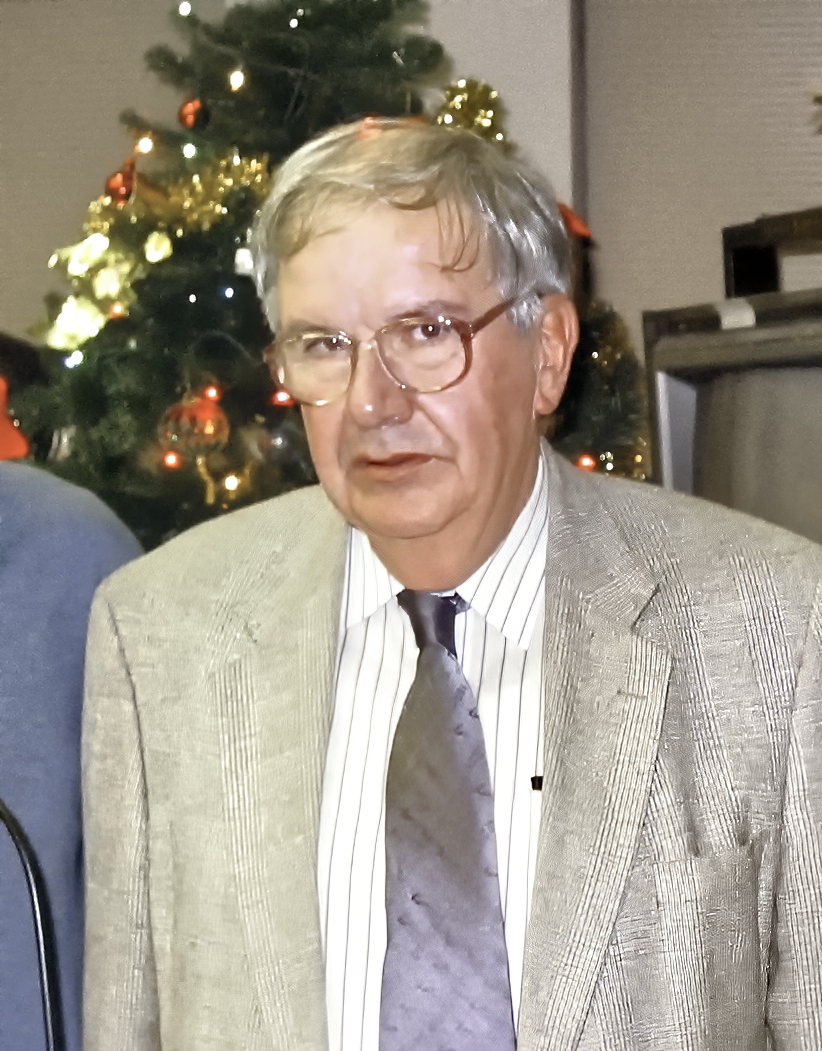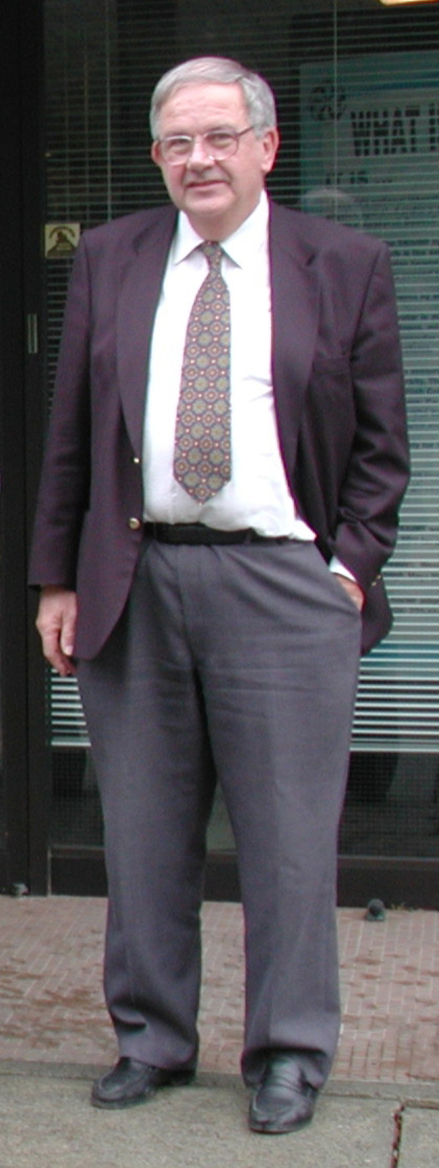
Gerardo Giovanni Dutto 1938 - 2020 | |
Gerardo Giovanni Dutto, Head of the TRIUMF Cyclotron Division from 1981 until his retirement in 2003, passed away in Nanaimo, Canada on February 13, 2020 after a long battle with ill health. Over the years Gerardo made many contributions to the development of cyclotron technology at TRIUMF and around the world, and his leadership was critical to the success and development of the accelerator operations and research program at TRIUMF. He was 81 years old.
Gerardo became the TRIUMF Cyclotron Division Head in 1981 when the divisional structure was set up by (then) incoming Director Erich Vogt, a position he maintained until his retirement in 2003. Over the course of those 22 years Gerardo had a major hand at shaping the laboratory, the capabilities of the accelerators, and the technical expertise within his Division. Gerardo’s tenure targeted continuous improvement of the cyclotron’s capabilities and reliability. Under his leadership, the cyclotron team demonstrated that 420mA was possible, quadruple the initial 100mA design goal. Such intensities were developed initially for the KAON factory proposal, but later became crucial for supplying the additional beamlines required for the ISAC and ARIEL radioisotope production facilities. Perhaps even more impressive was Gerardo’s commitment to cyclotron reliability. Now 46 years after first acceleration, the cyclotron has consistently achieved >90% availability, in large part due to the culture and expertise that Gerardo cultivated. During his final years at TRIUMF, Gerardo was involved in beam intensity stability developments for the multiple extracted beams, which was particularly important for ISAC to maximize production since the targets were being run near their limits.
Gerardo was a `people’ person with an amazing ability to bring people together. Within the Division he was famous for calling together the troops to make critical decisions. This ability extended far beyond the TRIUMF offices and included many memorable social gatherings. His generosity and humanity were major influences in building the culture within the Cyclotron Division and helped promote beneficial external collaborations. Long before the internet, Gerardo developed an impressive global network across the major laboratories. He would assemble expert teams of reviewers to assure projects were technically sound and he was successful at avoiding major technical blunders throughout his career. His global reach extended beyond well-known major labs in the USA and Europe to the (then) Soviet Union and China that were difficult to access in the geo-political environment of the time. He strongly believed that science and opportunity should not be restricted by borders and he developed meaningful and productive bridges with both the Soviet Union and China during this period. For TRIUMF these contacts provided access to international cyclotron physicists and engineers who would visit TRIUMF to work with the local staff. With his trademark powers of persuasion, a number of these visitors were convinced to stay in Vancouver with great benefit to the laboratory. As a reflection of Gerardo’s influence at fostering global scientific partnerships, the Chinese government awarded him the Friendship Prize in 2015, China’s highest award for "foreign experts who have made outstanding contributions to the country's economic and social progress” for his efforts in helping them develop their cyclotron-building expertise. And in 2004, Gerardo received from the President of Italy one of the highest honours bestowed on Italian Citizens: the Order of Cavaliere della Stella della Solidarieta’ “for promoting meaningful and productive relationship and collaborations between Italy and other countries”. Gerardo worked tirelessly to establish stronger ties between Italy and Canada in the field of scientific and technological research, evidenced by a long association with the Italian Chamber of Commerce in Canada, West, in Vancouver. Gerardo was also an active member of the international cyclotron community. In 1992 he was the program committee chair and an editor, along with Michael Craddock, for the 13th International Conference on Cyclotrons and their Applications held in Vancouver. Gerardo’s contributions to the community were recognized in 1998 when he was chosen as a Fellow of the American Physical Society `For contributions to the development of high-intensity H- cyclotrons both as meson facilities and for production of proton-rich radioisotopes.’ Gerardo is survived by his wife, Ludka Sulova, and two children Lorenzo and Daniela from his previous marriage to Marie-Paule Crettiez. His outsized personality and gregarious professionalism will be sorely missed by all that knew him. | |

 Gerardo Dutto was born on August 8, 1938 in Berlin, Germany. He received his doctorate in physics in 1971 from the University of Rome La Sapienza, while working on the Milan 45 MeV AVF H-minus cyclotron. Soon after Gerardo arrived at TRIUMF, where he joined the beam dynamics team (led by Michael Craddock) responsible for the beam optics and magnetic field requirements for the main 500 MeV H-minus cyclotron, which was under development at the time. He first worked with Ewart Blackmore on the Centre Region Cyclotron, a 3 MeV full-sized prototype of the main cyclotron centre region. He provided beam dynamics support and in particular the specifications for the correction plates (initially dubbed the “Dutto plates”) for vertical centring of the first few turns of the beam. These and other innovations improved the cyclotron’s beam-current performance by a factor of three over the original 100 microampere design specification. After the CRM cyclotron met its design requirements in 1972, Gerardo became part of the 500 MeV cyclotron commissioning team led by Reginald Richardson, which ultimately produced the first full energy beam in December 1974. Over the next few years he headed the task force which worked on increasing the cyclotron beam current to its design level of 100 microamps, where he initiated many upgrades required to obtain the requisite licensing. Examples include radiofrequency, controls, diagnostics, radiation and beam loss monitoring, as well as adding cooled collimators in the injection beamline to improve reproducibility and eliminate problems found with beam intensity limitations in the Centre Region.
Gerardo Dutto was born on August 8, 1938 in Berlin, Germany. He received his doctorate in physics in 1971 from the University of Rome La Sapienza, while working on the Milan 45 MeV AVF H-minus cyclotron. Soon after Gerardo arrived at TRIUMF, where he joined the beam dynamics team (led by Michael Craddock) responsible for the beam optics and magnetic field requirements for the main 500 MeV H-minus cyclotron, which was under development at the time. He first worked with Ewart Blackmore on the Centre Region Cyclotron, a 3 MeV full-sized prototype of the main cyclotron centre region. He provided beam dynamics support and in particular the specifications for the correction plates (initially dubbed the “Dutto plates”) for vertical centring of the first few turns of the beam. These and other innovations improved the cyclotron’s beam-current performance by a factor of three over the original 100 microampere design specification. After the CRM cyclotron met its design requirements in 1972, Gerardo became part of the 500 MeV cyclotron commissioning team led by Reginald Richardson, which ultimately produced the first full energy beam in December 1974. Over the next few years he headed the task force which worked on increasing the cyclotron beam current to its design level of 100 microamps, where he initiated many upgrades required to obtain the requisite licensing. Examples include radiofrequency, controls, diagnostics, radiation and beam loss monitoring, as well as adding cooled collimators in the injection beamline to improve reproducibility and eliminate problems found with beam intensity limitations in the Centre Region. Gerardo was very influential in supporting TRIUMF initiatives that opened up new avenues of research. For example, he oversaw the licensing to allow the cyclotron to safely extract small intensities for the proton cancer therapy irradiations. In the late 1980’s, he coordinated the beam dynamics team that produced the designs for the commercial high current medical cyclotrons (TR-19 and TR-30). This design was transferred to a local company (Advanced Cyclotron Systems Inc.) which has manufactured and sold many of these cyclotrons internationally. He was also a strong advocate and supporter of the development of industrial applications, including isotope production and the “Accelerator for Concealed Explosive Detection”. In the early 1990’s, while most of the site was focussed on the KAON factory proposal, Gerardo put together a small team of accelerator physicists to advance the design of a linear accelerator (linac) for radioactive ion beams, which later evolved into the ISAC post-accelerator. The development of linacs marked a paradigm shift where TRIUMF became known as more than just a cyclotron lab and paved the way for future developments such as superconducting radiofrequency linac technology. The ability of TRIUMF to learn and master new technologies while developing tools for scientific discovery or industrial application has led to an accelerator team with broad expertise. The roots of this strategy can be traced back to Gerardo’s influence.
Gerardo was very influential in supporting TRIUMF initiatives that opened up new avenues of research. For example, he oversaw the licensing to allow the cyclotron to safely extract small intensities for the proton cancer therapy irradiations. In the late 1980’s, he coordinated the beam dynamics team that produced the designs for the commercial high current medical cyclotrons (TR-19 and TR-30). This design was transferred to a local company (Advanced Cyclotron Systems Inc.) which has manufactured and sold many of these cyclotrons internationally. He was also a strong advocate and supporter of the development of industrial applications, including isotope production and the “Accelerator for Concealed Explosive Detection”. In the early 1990’s, while most of the site was focussed on the KAON factory proposal, Gerardo put together a small team of accelerator physicists to advance the design of a linear accelerator (linac) for radioactive ion beams, which later evolved into the ISAC post-accelerator. The development of linacs marked a paradigm shift where TRIUMF became known as more than just a cyclotron lab and paved the way for future developments such as superconducting radiofrequency linac technology. The ability of TRIUMF to learn and master new technologies while developing tools for scientific discovery or industrial application has led to an accelerator team with broad expertise. The roots of this strategy can be traced back to Gerardo’s influence.